Results
-
 £84.99
£84.99Yellow Mountains - Jacob de Haan
In October 1997, Jacob de Haan visited the Swiss village of St. Moritz, where he worked as a conductor with a symphonic wind band. The Mountains around St. Moritz were covered in marvelous autumn colors. The Colors, the quietness and nature itself inspired Jacob de Haan to compose this lyrical composition.
Estimated dispatch 7-14 working days
-
 £144.99
£144.99Ross Roy - Jacob de Haan
Jacob de Haan was commissioned to compose this concert piece by the "St. Peters Wind Symphony" from Brisbane, Australia. "Ross Roy" is the monumental late 19th century villa where St. Peters Lutheran College was founded in 1945. The villa has always remained the school symbol. In this composition, Jacob de Haan sees the "Ross Roy" as a metaphor for the years spent at school (a monument in time), where one's personality is formed. So, the opening theme the artist calls the Ross Roy theme initially has monumental characteristics.The rhythmic motion, which strides along in the lower register and percussion at the beginning of the next section is typical of "Tempo di Marcia". Thismovement, accompanied by repetitions of sound, is a metaphor for the structure and discipline in school. This is the introduction to a march theme, symbolic of "passing through" the classes up to the final examinations.Then, the Ross Roy theme is dealt with again, now in a playful, humorous variation. As if the composer is saying there should also be time for a smile in school. The same theme can be heard in major key and a slower tempo in the following section, expressing pride and self-confidence. This is also the introduction to the expressive middle section that represents love, friendship and understanding.We then return to the march theme in a slightly altered construction. The oriental sounds, constituting the modulation to the final theme, are symbols of the diversity of cultures in the school. The characteristic final theme first sounds solemn, but turns into a festive apotheosis. It is no coincidence that the final cadence is reminiscent of the close to a traditional overture, for the school years can be considered the "overture" to the rest of one's life. The premiere of "Ross Roy" was conducted by Jacob de Haan in Brisbane, on August 22, 1997.
Estimated dispatch 7-14 working days
-
£13.95
Dancing & Drumming
1Dancing and DrummingSusato/BertoffThe Central Band of the Royal Air Force2.262OvationMartin EllerbyThe Central Band of the Royal Air Force2.523Night and DayCole PorterThe Central Band of the Royal Air Force2.364Pineapple PollSullivan/MackarrasThe Central Band of the Royal Air Force5.555St. Louis BluesW.C. HandyThe Central Band of the Royal Air Force3.396Minstrel Boy/Toss the Feathersarr. WiffinThe Central Band of the Royal Air Force5.427Merry Wives of WindsorNicolai arr. GodfreyThe Central Band of the Royal Air Force5.428Woodchoppers' BallBishop & HermanThe Central Band of the Royal Air Force2.569MarschMarcel WenglerThe Central Band of the Royal Air Force3.1910Tiptoe TuneIrwin BertoffThe Central Band of the Royal Air Force3.4611Duel of the FatesJohn WilliamsThe Central Band of the Royal Air Force4.1412Royal Hunt of the SunMartin EllerbyThe Central Band of the Royal Air Force4.3413Music of the NightLlord Webber, Hart & StilgoeThe Central Band of the Royal Air Force4.2314Semper FidelisSousaThe Central Band of the Royal Air Force2.4415BoleroRavelThe Central Band of the Royal Air Force8.49
Estimated dispatch 7-14 working days
-
£13.95
Festival of Music 2002
1Here's a Health unto Her MajestySavile arr. Rob WiffinThe Massed Bands of the Royal Air Force3.312Elizabethan SerenadeRonald BingeThe Massed Bands of the Royal Air Force3.143Trumpet Tune and AirPurcellThe Massed Bands of the Royal Air Force2.274Haba?eraBizet arr. Rob WiffinBernadine Pritchett with The Massed Bands of the Royal Air Force4.365Finale: The Sword and the CrownEdward GregsonThe Massed Bands of the Royal Air Force4.156Berceuse from The Dolly SuiteFaur? arr. Rob WiffinThe Massed Bands of the Royal Air Force2.577633 SquadronRon GoodwinThe Massed Bands of the Royal Air Force2.428American PatrolMeacham/GreyThe Massed Bands of the Royal Air Force3.209Danse ProfaneJean Michel DefayeThe Massed Bands of the Royal Air Force2.1410The Beatles - Echoes of an Eraarr. John HigginsCorporal Matthew Little with The Massed Bands of the Royal Air Force9.0011Shining SwordRob WiffinThe Massed Bands of the Royal Air Force1.4812Fields of GoldSting arr. Rob WiffinBernadine Pritchett with The Massed Bands of the Royal Air Force3.4413St. Clements PreludeRob WiffinThe Massed Bands of the Royal Air Force4.2814FireworksHandel arr. Irwin BertoffThe Massed Bands of the Royal Air Force3.1315Pathfinders' MarchLockyer/FenoulhetThe Massed Bands of the Royal Air Force4.2916Who Can I Turn To?Bricusse & Newley arr. RichardsCorporal Matthew Little with The Massed Bands of the Royal Air Force2.3717Crown ImperialWilliam Walton arr. DuthoitThe Massed Bands of the Royal Air Force6.2018Royal Air Force March PastDavies & DysonThe Massed Bands of the Royal Air Force1.56
Estimated dispatch 7-14 working days
-
£13.95
From the Depths of Time
1Terra AustralisMartin EllerbyRoyal Northern College of Music Wind Orchestra12.542Pabiaga's HeartNicola RenshawRoyal Northern College of Music Wind Orchestra4.563Scarlet and GoldRob WiffinRoyal Northern College of Music Wind Orchestra5.244-6From the Depths of TimeDuncan StubbsRoyal Northern College of Music Wind Orchestra I. Igneous: 'Born of Fire' 3.39 II. Sedimentary: 'Laid to Rest' 4.39 III. Metamorphic: 'Born Anew' 5.557Acrid LinesTom HarroldRoyal Northern College of Music Wind Orchestra6.098In Flanders FieldsRob WiffinHelen Maxwell (Vocal) with Royal Northern College of Music Wind Orchestra3.469-13Mass of St. Thomas AquinasMartin EllerbyLeonie Maxwell (Vocal) with Royal Northern College of Music Wind Orchestra I. Kyrie 2.44 II. Gloria 2.14 III. Sanctus 2.54 IV. Benedictus 2.05 V. Agnus Dei 3.31
Estimated dispatch 7-14 working days
-
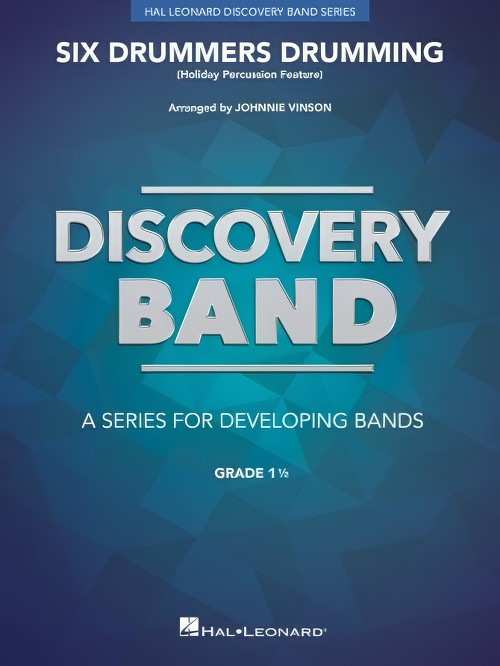 £53.50
£53.50Six Drummers Drumming (Percussion feature with Concert Band - Score and Parts) - Vinson, Johnnie
Using fragments from The Twelve Days of Christmas, Jolly Old St. Nicholas, and We Wish You A Merry Christmas, Johnnie has created a clever percussion feature sure to be a hit at your holiday concert and also fun for the entire band. The percussion parts can adjusted based on the number of players you have available, so just remember to change the title to fit your performance!Duration: 2.00
Estimated dispatch 7-14 working days
-
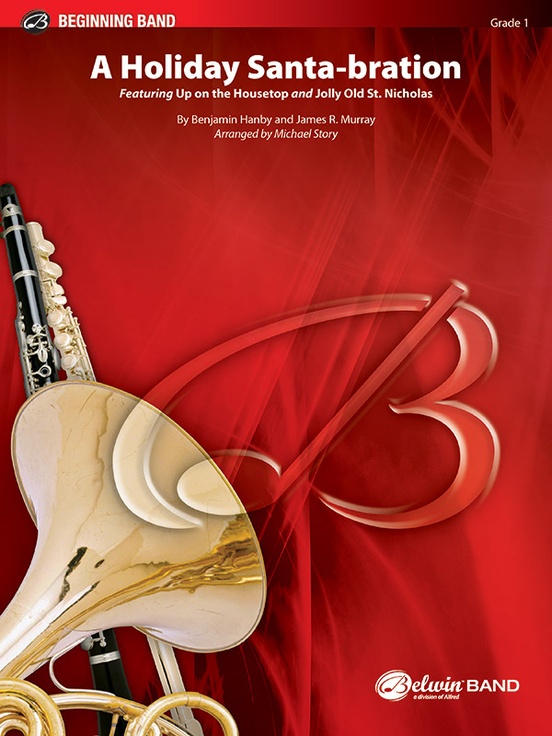 £53.95
£53.95A Holiday Santa-bration (Concert Band - Score and Parts) - Hanby & Murray - Story, Michael
A Holiday Santa-bration, arranged by Michael Story, is the perfect holiday selection for your beginning band. It includes two popular Christmas songs, Up on the Housetop and Jolly Old St. Nicholas. This arrangement can be performed with even or swinging eighth notes, it is equally effective!Duration: 2.00
Estimated dispatch 7-14 working days
-
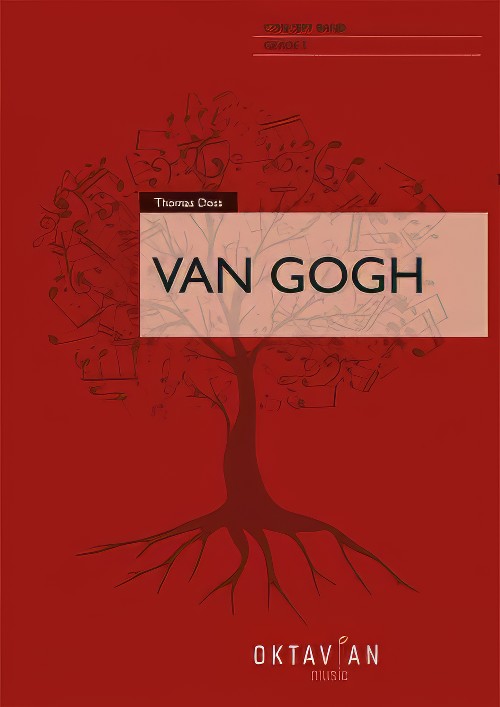 £279.99
£279.99Van Gogh (Concert Band - Score and Parts) - Doss, Thomas
This composition is not a work inspired by the life of the famous painter, but rather an attempt at a pictorial immersion into his world. In addition to Van Gogh's character and tragic life, the technique he employed to create his works, the bright colours of his paintings and his view of nature served as inspiration for this musical work. Point by point, stroke by stroke, Van Gogh brought his own world to life on canvas.On the life of Van Gogh: The Dutch artist Vincent van Gogh was one of the most important pioneers of Modernism, despite being relatively unknown during his own lifetime. As an artist, he chose a life of poverty and seclusion. From today's perspective, his important woks were created from 1880 onwards, when he had already more or less succumbed to madness. While his earlier works could still be classed as contemporary, he matured into a pioneer of Expressionism with his later work indicating an increasing self-awareness. He was just 37 years old when he died but he created over 750 paintings and 1600 drawings in the last ten years of his life.The structure of the work:Start: Brushes and Paints: Van Gogh retired to Arles in southern France where he found his artistic home. The colours and flowering gardens of this landscape awakened in him an unbelievably great creative power.A: A Picture Comes into Being: Van Gogh's psychotic episodes and bouts of depression did not stop him from painting wonderful pictures. Hardly anyone recognised his genius during his lifetime, on the contrary, he often felt misunderstood.C: Paris - Arles: In Paris (from 1886), Van Gogh became inspired by the French art scene. His works found few takers, however. He met and befriended the painter Paul Gauguin, but the lack of success made Van Gogh short tempered, and he began to drink. Eventually, he moved from Paris to Arles in the south of France to establish an artists' collective with Gaugin. Within a few weeks, the two got into such a violent argument that Van Gogh attacked his friend with a knife. The friends parted ways and afterwards Van Gogh cut off his right ear. In 1889 he voluntarily admitted himself into a mental hospital at St. Remy, suffering from hallucinations and fearing that he would lose his mind.G: The Starry Night One of his most famous paintings, created in 1898.H: Death and Brotherly Love Vincent van Gogh accepted an invitation to Auver-sur-Oise in 1890. This was one of his most intensive creative periods. He also went there for treatment, but his mental state hardly improved. After an extended walk, he injured himself fatally with a pistol under mysterious circumstances. Not even to his beloved brother Theo, who had supported him all his life, did he reveal on his deathbed how the accident had occurred.J: Art Market Today, Van Gogh's paintings are among the most expensive paintings on the art market. How ironic, given that he could hardly sell a painting during his lifetime. "I put my heart and soul into my work and lost my mind in the process." (Vincent van Gogh)Duration: 13.15
Estimated dispatch 7-14 working days
-
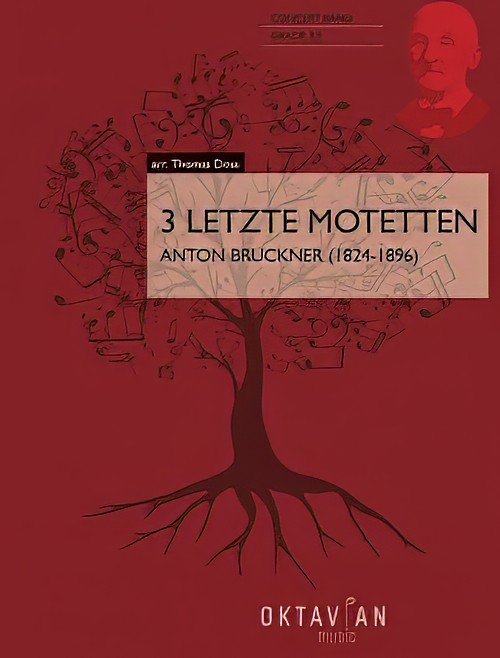 £123.20
£123.203 Letzte Motetten (Concert Band - Score and Parts) - Bruckner, Anton - Doss, Thomas
Anton Bruckner (b. 4.9.1824, Ansfelden, d. 11.10.1896, Vienna) didn't have it easy. Throughout his life, the Austrian composer was plagued by self-doubt. Anton Bruckner came from a simple, rural background. After the death of his father, he was accepted as a choirboy at the monastery of Sankt Florian in 1837. After several years as a school assistant and his own organ and piano studies, he first worked as organist in St. Florian, then from 1855 as cathedral organist in Linz. Introduced to music theory and instrumentation by Simon Sechter and Otto Kitzler, he discovered Richard Wagner as an artistic role model, whom he admired throughout his life and also visited several times in Bayreuth. In 1868 Anton Bruckner became professor of basso continuo, counterpoint and organ at the Vienna Conservatory; ten years later court organist; and in 1891 finally honorary doctor of the University of Vienna. He was considered an important organ virtuoso of his era, but had to wait a long time for recognition as a composer. It was not until Symphony No.7 in E major, composed between 1881 and 1883, with the famous Adagio written under the effects of Wagner's death, that he achieved the recognition he had hoped for, even if he was reluctant to accept it given his inclination towards scepticism and self-criticism. Anton Bruckner was a loner who did not want to follow a particular school or doctrine. He composed numerous sacred vocal works, such as his three masses, the Missa Solemnis in B flat minor (1854), the Te Deum (1881-84) and numerous motets. As a symphonic composer, he wrote a total of nine symphonies and many symphonic studies from 1863 onwards, tending to revise completed versions several times over. Bruckner's orchestral works were long considered unplayable, but in fact were merely exceptionally bold for the tonal language of their time, uniting traditions from Beethoven through Wagner to folk music, on the threshold between late Romanticism and Modernism. Anton Bruckner composed about 40 motets during his lifetime, the earliest a setting of Pange lingua around 1835, and the last, Vexilla regis, in 1892. Thomas Doss has compiled some of these motets in this volume for symphonic wind orchestra. These motets show many characteristics of personal expression, especially Bruckner's colourful harmony in the earlier works, which is in places aligned with Franz Schubert (changes between major and minor; and movements in thirds). Later works are characterised by many components which, in addition to the expanded stature of the movements, include above all a sense of the instrumentation as an outward phenomenon and the harmony as a compositional feature that works more internally. Some aspects of Bruckner's work are the result of his long period of study, which familiarised him not only with the tradition of his craft, but also gave him insights into the "modernity" of his time in such composers as Wagner, Liszt and Berlioz. From this developed his personal standpoint, which always pursues the connection between the old and the new.Duration: 14.00
Estimated dispatch 7-14 working days
-
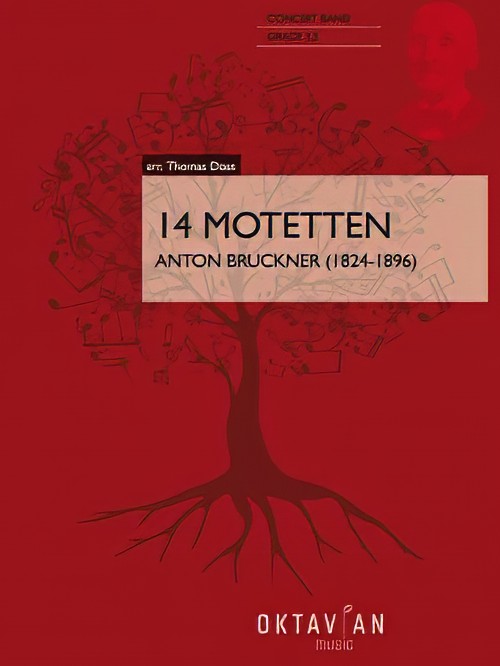 £256.00
£256.0014 Motetten (Concert Band - Score and Parts) - Bruckner, Anton - Doss, Thomas
Anton Bruckner (b. 4.9.1824, Ansfelden, d. 11.10.1896, Vienna) didn't have it easy. Throughout his life, the Austrian composer was plagued by self-doubt. Anton Bruckner came from a simple, rural background. After the death of his father, he was accepted as a choirboy at the monastery of Sankt Florian in 1837. After several years as a school assistant and his own organ and piano studies, he first worked as organist in St. Florian, then from 1855 as cathedral organist in Linz. Introduced to music theory and instrumentation by Simon Sechter and Otto Kitzler, he discovered Richard Wagner as an artistic role model, whom he admired throughout his life and also visited several times in Bayreuth. In 1868 Anton Bruckner became professor of basso continuo, counterpoint and organ at the Vienna Conservatory; ten years later court organist; and in 1891 finally honorary doctor of the University of Vienna. He was considered an important organ virtuoso of his era, but had to wait a long time for recognition as a composer. It was not until Symphony No.7 in E major, composed between 1881 and 1883, with the famous Adagio written under the effects of Wagner's death, that he achieved the recognition he had hoped for, even if he was reluctant to accept it given his inclination towards scepticism and self-criticism. Anton Bruckner was a loner who did not want to follow a particular school or doctrine. He composed numerous sacred vocal works, such as his three masses, the Missa Solemnis in B flat minor (1854), the Te Deum (1881-84) and numerous motets. As a symphonic composer, he wrote a total of nine symphonies and many symphonic studies from 1863 onwards, tending to revise completed versions several times over. Bruckner's orchestral works were long considered unplayable, but in fact were merely exceptionally bold for the tonal language of their time, uniting traditions from Beethoven through Wagner to folk music, on the threshold between late Romanticism and Modernism. Anton Bruckner composed about 40 motets during his lifetime, the earliest a setting of Pange lingua around 1835, and the last, Vexilla regis, in 1892. Thomas Doss has compiled some of these motets in this volume for symphonic wind orchestra. These motets show many characteristics of personal expression, especially Bruckner's colourful harmony in the earlier works, which is in places aligned with Franz Schubert (changes between major and minor; and movements in thirds). Later works are characterised by many components which, in addition to the expanded stature of the movements, include above all a sense of the instrumentation as an outward phenomenon and the harmony as a compositional feature that works more internally. Some aspects of Bruckner's work are the result of his long period of study, which familiarised him not only with the tradition of his craft, but also gave him insights into the modernity of his time in such composers as Wagner, Liszt and Berlioz. From this developed his personal standpoint, which always pursues the connection between the old and the new.Duration: 39.00
Estimated dispatch 7-14 working days
